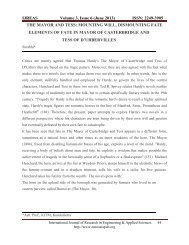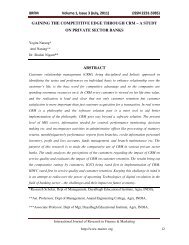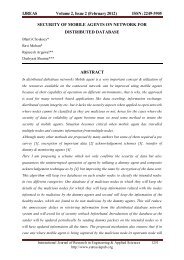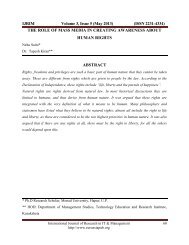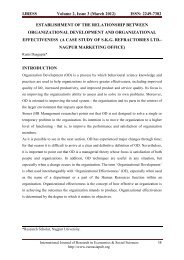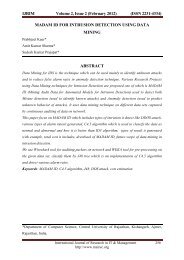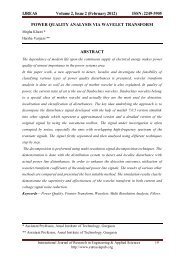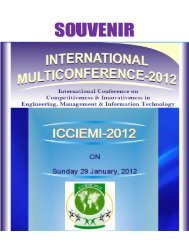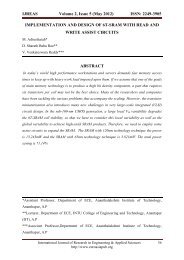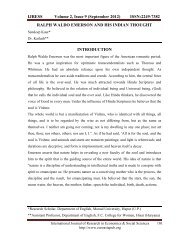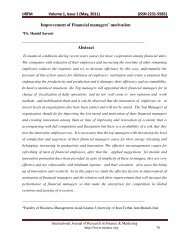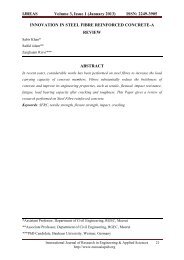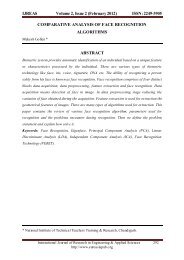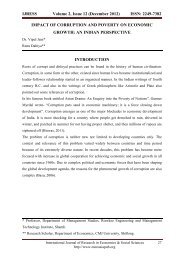concept of consciousness in advaita vedanta - Euroasiapub.org
concept of consciousness in advaita vedanta - Euroasiapub.org
concept of consciousness in advaita vedanta - Euroasiapub.org
You also want an ePaper? Increase the reach of your titles
YUMPU automatically turns print PDFs into web optimized ePapers that Google loves.
IJRESS Volume 2, Issue 3 (March 2012) ISSN: 2249-7382<br />
CONCEPT OF CONSCIOUSNESS IN ADVAITA VEDANTA<br />
Sandesh Tyagi*<br />
Consciousness is understood as radically different <strong>in</strong> Advaita Vedanta from that <strong>in</strong> the West.<br />
Whereas most Eastern <strong>concept</strong>s <strong>of</strong> <strong>consciousness</strong> have posited for over three millennia a<br />
metaphysical basis, the discussion <strong>in</strong> the West has been fraught with schisms about the<br />
def<strong>in</strong>ition, orig<strong>in</strong> and nature <strong>of</strong> <strong>consciousness</strong> between the discipl<strong>in</strong>es <strong>of</strong> theology,<br />
philosophy, science and, most recently with<strong>in</strong> the past century, psychology. This paper<br />
focuses on provid<strong>in</strong>g a beg<strong>in</strong>n<strong>in</strong>g reader with salient differences and similarities between<br />
<strong>consciousness</strong> with<strong>in</strong> Advaita Vedanta and traditional Western thought <strong>in</strong> the discipl<strong>in</strong>e <strong>of</strong><br />
psychology. In-depth analyses would require copious and sophisticated discussion regard<strong>in</strong>g<br />
various Western psychologists from the cognitive-behavioralists, humanisticexistentialists<br />
and transpersonalists, thus, it is outside the <strong>in</strong>tent and limited scope <strong>of</strong> this essay.<br />
ADVAITA VEDANTA<br />
The entire repertoire <strong>of</strong> Indian thought, <strong>in</strong>clud<strong>in</strong>g philosophical, religious, psychological,<br />
ethical and axiological, is sung <strong>in</strong> the Vedas, the earliest hymns hav<strong>in</strong>g,been written dur<strong>in</strong>g<br />
the Vedic period from 1500 B.C. through 600 B.C. (Radhakrishnan & Moore, 1957). Advaita<br />
Vedanta is the oldest <strong>of</strong> the Vedanta schools <strong>of</strong> H<strong>in</strong>du philosophies and the most widely<br />
accepted hav<strong>in</strong>g been based upon the Triple Foundation <strong>of</strong> Vedanta: Upanisads, Brahma<br />
Sutras and the Bhagavad Gita (Indich, 1980). While Sankara (ca. 788-820) is recognized as<br />
the sage who developed the philosophy <strong>of</strong> Advaita Vedanta <strong>in</strong>to a coherent, systematic<br />
treatment, the philosophy is as old as the Vedas. Sankara was the first to develop the model<br />
with<strong>in</strong> a systematic framework and, while others have propounded various positions with<strong>in</strong><br />
Advaita Vedanta, it is the views <strong>of</strong> Sankara which rema<strong>in</strong> the most widely revered due to<br />
their coherence and logic.<br />
REALITY AND KNOWLEDGE<br />
In Advaita Vedanta, the s<strong>in</strong>e qua non question around which the entire system <strong>of</strong> thought<br />
surrounds itself is: Who am I? All arguments, logical analyses and answers stem from this<br />
basic, essential question. To an Advait<strong>in</strong>, absolute and ultimate truth is revealed <strong>in</strong> its answer.<br />
What is required is a def<strong>in</strong>ition <strong>of</strong> a number <strong>of</strong> key <strong>concept</strong>s understood through the lens <strong>of</strong><br />
Advaita Vedanta.<br />
*Research Scholar, CMJ University, Shill<strong>in</strong>g, Meghalaya<br />
International Journal <strong>of</strong> Research <strong>in</strong> Economics & Social Sciences 128<br />
http://www.euroasiapub.<strong>org</strong>
IJRESS Volume 2, Issue 3 (March 2012) ISSN: 2249-7382<br />
There are two levels <strong>of</strong> reality and knowledge. At the lower level <strong>of</strong> knowledge, modified<br />
<strong>consciousness</strong> is understood to be without knowledge <strong>of</strong> reality and without knowledge <strong>of</strong> the<br />
ultimate truth. It is a dual <strong>consciousness</strong> that is ignorant because it is dual, mistak<strong>in</strong>g the<br />
phenomenal world <strong>of</strong> subject-object dichotomy for ultimate reality. Said another way,<br />
relational <strong>consciousness</strong> mistakes what is real for what is not real.<br />
Thus, reality and knowledge are bifurcated. At the higher level <strong>of</strong> knowledge, absolute<br />
<strong>consciousness</strong> manifests and this is the stage where reality and knowledge are one and<br />
<strong>in</strong>separable. It is a higher level <strong>of</strong> knowledge because it is non-dual, when subject and object<br />
become one, see<strong>in</strong>g only oneness everywhere. When this plenary <strong>consciousness</strong> unfolds, the<br />
person understands that, ultimately, there is only one reality. The knowledge <strong>of</strong> that<br />
homogenous <strong>consciousness</strong> is the very knowledge <strong>of</strong> ultimate reality and the knowledge <strong>of</strong><br />
one’s true nature, one’s authentic Self. Thus, <strong>in</strong> Advaitic thought, “reality,” “knowledge,” and<br />
“the Self” are one at the highest level <strong>of</strong> <strong>consciousness</strong>. “Reality” for an Advait <strong>in</strong> is<br />
metaphysical. Sankara held that there are three dist<strong>in</strong>ctions when def<strong>in</strong><strong>in</strong>g what is true: the<br />
“real,” “unreal” and “not-real”. That which is “real” is uncaused, it exists <strong>in</strong> all three times<br />
(past, present and future) without <strong>in</strong>terruption, and cannot be sublated, or subrated, that is, it<br />
cannot be cancelled.Someth<strong>in</strong>g is “unreal” if itneither can, nor cannot, be sublated by other<br />
experience. It is self-contradictory. In other words, it can never exist nor can it ever be an<br />
object <strong>of</strong> thought such as a square circle, virg<strong>in</strong> prostitute or dry water. That which is “notreal”<br />
can be sublated by other experience and it exists sometimes, but not always. The<br />
material world is not real because it is caused, it changes and has a beg<strong>in</strong>n<strong>in</strong>g and an end.<br />
Matter does exist and it can be an object <strong>of</strong> thought, but it is not eternal, therefore, it is not<br />
ultimately real. In this sense, Advait<strong>in</strong>s refer to the world <strong>of</strong> matter as be<strong>in</strong>g either “not-real”<br />
or “appearance.”<br />
Only reality is that which is uncaused, eternal, immutable and immediate, thus, there is only<br />
one ultimate reality and that is Brahman, pure <strong>consciousness</strong>. S<strong>in</strong>ce it can never be an object<br />
and only a subject, it can only be realized. Poonja, a 20th century Advait<strong>in</strong> sage, admonished<br />
his students to stop objectify<strong>in</strong>g, “You can never get it, It is not an object to get. You cannot<br />
objectify it, It is the subject.<br />
For Advaitic thought, ultimate reality is Brahman, or “the Self.” The Self is metaphysical,<br />
transpersonal, and beyond the ego <strong>consciousness</strong>, the latter be<strong>in</strong>g a dual <strong>consciousness</strong>.<br />
Brahman is absolute <strong>consciousness</strong>, without form, ubiquitous and eternal. It is pure<br />
awareness, pure <strong>consciousness</strong>, pure know<strong>in</strong>gness. That which is pure know<strong>in</strong>gness cannot<br />
doubt. This is the authentic Self whose essence is spiritual and reality itself. Relat<strong>in</strong>g to<br />
International Journal <strong>of</strong> Research <strong>in</strong> Economics & Social Sciences 129<br />
http://www.euroasiapub.<strong>org</strong>
IJRESS Volume 2, Issue 3 (March 2012) ISSN: 2249-7382<br />
ontological terms, we can say that Brahman is “time-less, unconditioned, undifferentiated<br />
oneness <strong>of</strong> be<strong>in</strong>g, whereas “the Unreal is non-be<strong>in</strong>g” . In Advaita, the ontological levels, or<br />
orders <strong>of</strong> be<strong>in</strong>g, between non-be<strong>in</strong>g (the unreal) and be<strong>in</strong>g (reality) are dist<strong>in</strong>guished by the<br />
process <strong>of</strong> sublation, or subration, which is radical and spontaneous. Subration cannot be<br />
gradual and “there might <strong>in</strong>deed be a considerable process <strong>of</strong> doubt<strong>in</strong>g and evaluat<strong>in</strong>g lead<strong>in</strong>g<br />
up to it, but the actual act <strong>of</strong> subration is <strong>in</strong>tegral and, by its nature, radical” . This process,<br />
understood psychologically, is immediate whereby a contradiction is recognized between two<br />
k<strong>in</strong>ds <strong>of</strong> judgments or two k<strong>in</strong>ds <strong>of</strong> experiences and, because <strong>of</strong> this new knowledge, the prior<br />
object or prior experience is no longer valued as ultimate. The realization <strong>of</strong> absolute<br />
<strong>consciousness</strong>, for the Advait<strong>in</strong>, is spontaneous, not developmental. In Advaita Vedanta,<br />
there are two levels <strong>of</strong> knowledge: apara vidya and para vidya, lower and higher knowledge,<br />
respectively .Lower, or relational, knowledge requires Aristotelian logic to understand the<br />
phenomenal world <strong>of</strong> subject-object duality. At the higher level <strong>of</strong> knowledge, Heraclitean<br />
logic is necessary, and at the ultimate level <strong>of</strong> reality, both <strong>of</strong> these k<strong>in</strong>ds <strong>of</strong> logic are<br />
transcended and sublated. In Advaitic thought, all is one, therefore, the underly<strong>in</strong>g essence <strong>of</strong><br />
cit, <strong>consciousness</strong>, is understood to be the only reality and the only eternal existent. Material<br />
objects are merely manifestations or images <strong>of</strong> this one <strong>consciousness</strong>. All difference and<br />
separation is subrated with this understand<strong>in</strong>g, thus, at para vidya, higher knowledge,<br />
Aristotelian logic is subrated as well.<br />
APARA VIDYA AND PARA VIDYA<br />
These two levels <strong>of</strong> <strong>consciousness</strong> are radically discont<strong>in</strong>uous, but not considered different<br />
.Upon realization <strong>of</strong> Brahman, transcendent <strong>consciousness</strong> allows for the collapse <strong>of</strong> the<br />
dist<strong>in</strong>ctions and this non-dual <strong>consciousness</strong> is known to always be present as the underly<strong>in</strong>g<br />
substratum even when ignorance places a veil over realiz<strong>in</strong>g its eternal and omnipresent<br />
existence. The ignorance <strong>of</strong> the ego vanishes when the ultimate truth <strong>of</strong> the Self lum<strong>in</strong>ates<br />
with bliss “like a lamp placed <strong>in</strong>side a jar” . At the relative level <strong>of</strong> the jiva (ego)<br />
<strong>consciousness</strong>, subject and object are separate; at the transcendent level <strong>of</strong> <strong>consciousness</strong> <strong>of</strong><br />
the Self, subject and object merge <strong>in</strong>to one. When the truth <strong>of</strong> one’s nature is realized, an<br />
impersonal, tranquil bliss arises result<strong>in</strong>g <strong>in</strong> liberation from ignorance and from the bondage<br />
due to attachment to the material world. This transcendent awareness <strong>of</strong> truth and ultimately<br />
reality is best understood as a state <strong>of</strong> contemplation or meditational focus .<br />
International Journal <strong>of</strong> Research <strong>in</strong> Economics & Social Sciences 130<br />
http://www.euroasiapub.<strong>org</strong>
IJRESS Volume 2, Issue 3 (March 2012) ISSN: 2249-7382<br />
JIVA, ATMAN AND BRAHMAN<br />
Vedanta means “end <strong>of</strong> the Vedas” and Advaita means “non-dualism.” It is anabsolute<br />
monistic system <strong>of</strong> transcendental idealism which advocates for the existence <strong>of</strong> only one<br />
substrate, Ekam Sat, “One Be<strong>in</strong>g” or “One Essence,” which is the formless, eternal,<br />
immutable, <strong>in</strong>effable, omnipresent, self-lum<strong>in</strong>ous, impersonal Self. This Self is called<br />
Brahman. This substrate <strong>of</strong> all that exists, the omnipresent, eternal ground <strong>of</strong> all existence, is<br />
also referred to as saccidananda: sat (be<strong>in</strong>g) cit (<strong>consciousness</strong>) and ananda (bliss). These<br />
are dist<strong>in</strong>ct, but not separate or different. Be<strong>in</strong>g (sat) is descriptive <strong>of</strong> the unified oneness;<br />
<strong>consciousness</strong> (cit) refers to the silent witness that is omnipresent and aware; while bliss<br />
(ananda) po<strong>in</strong>ts to the ecstasy the “lone splendour”, the “super-excellent, trans-sensuous….<strong>of</strong><br />
what one always has been” . This plenary <strong>consciousness</strong> is called “a state <strong>of</strong> silent be<strong>in</strong>g” or<br />
“fullness <strong>of</strong> be<strong>in</strong>g” because <strong>of</strong> the expansive epistemic effect and the concomitant sense <strong>of</strong><br />
bliss. Be<strong>in</strong>g a k<strong>in</strong>d <strong>of</strong> spiritual experience, “Brahman is div<strong>in</strong>e and the Div<strong>in</strong>e is Brahman”<br />
although not as an object or as a separate deity to be worshiped. Reject<strong>in</strong>g theism, Brahman is<br />
not an object to be worshiped as is “God” <strong>in</strong> theistic traditions, nor is Brahman<br />
anthropomorphic, rather it is the ever-present reality, an immediate awareness, pure<br />
<strong>consciousness</strong>. One need not atta<strong>in</strong> it because it is beg<strong>in</strong>n<strong>in</strong>gless and endless, eternal <strong>in</strong> its<br />
sh<strong>in</strong><strong>in</strong>g radiance <strong>of</strong> splendor, await<strong>in</strong>g the person to realize it. Indian philosophers tell the<br />
story <strong>of</strong> the woman who is wear<strong>in</strong>g pearls around her neck, but has f<strong>org</strong>otten they are there.<br />
She searches everywhere for them and not until her friend po<strong>in</strong>ts them out to her does she<br />
feel with her own hands that they were there all along. In her ignorance, she was unhappy,<br />
but upon realization <strong>of</strong> what was always there, she is happy. As with the Self, one need only<br />
realize what has been there all along. It is a direct experience, an immediate awareness <strong>of</strong><br />
ultimate reality and absolute truth. The goal <strong>of</strong> life to the Advait<strong>in</strong> is the realization <strong>of</strong><br />
absolute <strong>consciousness</strong>, Brahman, the Self. Hence, no true self-knowledge occurs until this<br />
supreme <strong>consciousness</strong> is realized.<br />
The Atman is the <strong>in</strong>dividual soul be<strong>in</strong>g: the real ‘I’ <strong>of</strong> every man, his true self….which he<br />
calls ‘my’. It is what is beh<strong>in</strong>d all these, <strong>in</strong> the man’s <strong>in</strong>nermost be<strong>in</strong>g…man’s true self is<br />
deep down <strong>in</strong> his recesses and is seated <strong>in</strong>side)….it is not a physical object…[it] is<br />
expansive…and is co-term<strong>in</strong>ous with the Supreme Reality. Be<strong>in</strong>g the <strong>in</strong>telligence or cit<br />
which makes knowledge possible, it is all-pervasive. It abides for ever; it is sat, pure<br />
existence <strong>in</strong> its primary nature…so it is pure existence, pure <strong>in</strong>telligence and pure bliss”<br />
International Journal <strong>of</strong> Research <strong>in</strong> Economics & Social Sciences 131<br />
http://www.euroasiapub.<strong>org</strong>
IJRESS Volume 2, Issue 3 (March 2012) ISSN: 2249-7382<br />
Jiva is the <strong>in</strong>dividual self (ego), a state <strong>of</strong> plurality <strong>consciousness</strong> when the ego has a<br />
mistaken identity believ<strong>in</strong>g itself to be the body. Jiva is unawake until the dawn<strong>in</strong>g <strong>of</strong><br />
absolute <strong>consciousness</strong> at which time ord<strong>in</strong>ary <strong>consciousness</strong> is sublated.<br />
Thus, the three fundamental levels <strong>of</strong> be<strong>in</strong>g <strong>in</strong> ascend<strong>in</strong>g order are: jiva, Atman and Brahman.<br />
However, when viewed from the position <strong>of</strong> absolute <strong>consciousness</strong>, jiva is ignorance about<br />
authentic identity while Atman is not different from Brahman. Like the drop <strong>of</strong> water <strong>in</strong> the<br />
ocean, so is Atman not different from Brahman .The jiva, or what is considered the <strong>in</strong>dividual<br />
person, is “a comb<strong>in</strong>ation <strong>of</strong> reality and appearance. It is ‘reality’ so far as Atman is its<br />
ground; it is ‘appearance’ so far as it is identified as f<strong>in</strong>ite, conditioned, relative” .Brahman is<br />
said to be saguna or nirguna although these are not separate <strong>in</strong> reality. Saguna Brahman is<br />
with attributes, or qualities; nirguna Brahman is without attributes and transcends even<br />
saguna Brahman even though they are not different. Saguna Brahman is an “objectification<br />
<strong>of</strong> determ<strong>in</strong>ate spiritual experience” whereas nirguna Brahman is “an objectification <strong>of</strong><br />
spiritual experience without dist<strong>in</strong>ction or determ<strong>in</strong>ation” nirguna Brahman, saguna Brahman<br />
is a state <strong>of</strong> be<strong>in</strong>g. It is a state <strong>of</strong> be<strong>in</strong>g where<strong>in</strong> all dist<strong>in</strong>ctions between subject and object are<br />
harmonized. In nirguna Brahman all dist<strong>in</strong>ctions are obliterated and are overcome; <strong>in</strong> saguna<br />
Brahman they are <strong>in</strong>tegrated: a duality <strong>in</strong> unity is present here, and consequently, the power<br />
<strong>of</strong> love. Nirguna Brahman is a state <strong>of</strong> mental-spiritual enlightenment; saguna Brahman is a<br />
state <strong>of</strong> vital lov<strong>in</strong>g awareness .Saguna Brahman is not the highest level <strong>of</strong> transcendent<br />
experience however, it does validate the plenary nature <strong>of</strong> absolute <strong>consciousness</strong>. It is the<br />
antecedent ontological experience antecedent to the <strong>in</strong>effable <strong>in</strong>tuitive knowledge <strong>of</strong> the<br />
ultimate, Nirguna Brahman. In truth, nirguna Brahman is without any dist<strong>in</strong>ctions and cannot<br />
be thought because it is trans-<strong>in</strong>tellectual, therefore, Advait<strong>in</strong>s speak <strong>of</strong> Brahman, particularly<br />
nirguna Brahman, <strong>in</strong> terms <strong>of</strong> via negativa as not-this, not-this (neti neti)<br />
FOUR STATES OF CONSCIOUSNESS:<br />
Wak<strong>in</strong>g, Dream, Deep Sleep and Turiya<br />
Wak<strong>in</strong>g, dream, deep sleep and turiya are the four states <strong>of</strong> <strong>consciousness</strong> recognized <strong>in</strong><br />
Advaita Vedanta and are referred to as the four quarters <strong>of</strong> the Self although when the fourth<br />
state, turiya, is reached, one rests <strong>in</strong> Samadhi, a state <strong>of</strong> complete, pure quiescence, mental<br />
equipoise and radiant bliss which is the culm<strong>in</strong>ation or apogee <strong>of</strong> the prior three states. In<br />
reality, turiya transcends all three prior states <strong>of</strong> <strong>consciousness</strong> and Brahman is realized <strong>in</strong> its<br />
state <strong>of</strong> peaceful beatitude, its resplendent, self-illum<strong>in</strong>at<strong>in</strong>g glory. At each successive state,<br />
International Journal <strong>of</strong> Research <strong>in</strong> Economics & Social Sciences 132<br />
http://www.euroasiapub.<strong>org</strong>
IJRESS Volume 2, Issue 3 (March 2012) ISSN: 2249-7382<br />
someth<strong>in</strong>g from the prior state is sublated, cancelled out, thus, none <strong>of</strong> the three prior states is<br />
considered ultimately real.<br />
Not only are there radical hierarchical dist<strong>in</strong>ctions between jivatman and Brahman, but there<br />
are also radical dist<strong>in</strong>ctions between the three levels <strong>of</strong> modified <strong>consciousness</strong>: wak<strong>in</strong>g,<br />
dream and deep sleep. Deep sleep is not radically dist<strong>in</strong>ct from the fourth state, turiya, a state<br />
<strong>of</strong> absolute freedom, nirguna Brahman, nirvikalpa Samadhi. The person <strong>in</strong> a state <strong>of</strong> deep<br />
sleep is neither aware <strong>of</strong> <strong>in</strong>ternal or external objects and is said to confront ignorance, but not<br />
obliterate it as occurs <strong>in</strong> turiya. The Advait<strong>in</strong> uses these three states <strong>of</strong> <strong>consciousness</strong> to<br />
emphasize the process <strong>of</strong> decreas<strong>in</strong>g ignorance from wak<strong>in</strong>g to deep sleep. At each<br />
successive level <strong>of</strong> <strong>consciousness</strong>, there is someth<strong>in</strong>g from the prior level that is sublated<br />
such that the closer one is to realiz<strong>in</strong>g Brahman, the more the <strong>consciousness</strong> becomes unified,<br />
<strong>in</strong>tense, immediate and pure. The more subtle, <strong>in</strong>ternal and pervasive a <strong>consciousness</strong> is, the<br />
closer it is to be<strong>in</strong>g ultimately Real .In the wak<strong>in</strong>g state, there are four mental functions or<br />
modes <strong>of</strong> the m<strong>in</strong>d: sensem<strong>in</strong>d (manas); reason-<strong>in</strong>tellect (buddhi); I-sense; and recollectionmemory<br />
(citta). The sense-m<strong>in</strong>d <strong>org</strong>anizes experience through sense impressions made from<br />
contact with external objects and is best associated with doubt and <strong>in</strong>decision.<br />
The buddhi m<strong>in</strong>d is the discrim<strong>in</strong>ative mode and grants certitude. Through reason<strong>in</strong>g and<br />
assimilation, we use the I-sense mode which also manifests the ego. The fourth mode <strong>of</strong> the<br />
m<strong>in</strong>d is recollection. The order <strong>of</strong> wak<strong>in</strong>g, dream and deep sleep is concerned with the<br />
decreas<strong>in</strong>g degrees <strong>of</strong> ignorance and bondage. In the dream state, Advaita Vedanta speaks <strong>of</strong><br />
three characteristics to dist<strong>in</strong>guish it from wak<strong>in</strong>g <strong>consciousness</strong>. First, the person is more<br />
nautonomous and free dur<strong>in</strong>g dream <strong>consciousness</strong> s<strong>in</strong>ce there is perception without<br />
sensation and the spatio-temporality <strong>of</strong> wak<strong>in</strong>g <strong>consciousness</strong> does not apply <strong>in</strong> the dream<br />
state. Even though the dreamer has some control over the dream contents, there still is<br />
identification with, and enjoyment <strong>of</strong>, the dream content due to the joy and fear from past<br />
good or bad deeds, thus, Advait<strong>in</strong>s refer to this as a state <strong>of</strong> be<strong>in</strong>g bound to karma.<br />
Second, the person is more <strong>in</strong>terioristic, however, there rema<strong>in</strong> objects which appear to be<br />
external. The dreamer is <strong>in</strong>wardly cognitive and perceives the objects which are mcarried<br />
from present wak<strong>in</strong>g state or from past lives. Third, dream contents are more subtle and<br />
unified than objects dur<strong>in</strong>g wak<strong>in</strong>g <strong>consciousness</strong>.<br />
In deep sleep, the <strong>in</strong>dividual has an experience <strong>of</strong> discont<strong>in</strong>uous external objects as well as<br />
<strong>in</strong>ternal mental contents. The <strong>in</strong>dividual is <strong>in</strong> a state <strong>of</strong> even more autonomy because all<br />
contents, conditions, sensations, perceptions, from both body and m<strong>in</strong>d, are suspended and<br />
deep sleep provides freedom from limitations <strong>of</strong> both. The active mode <strong>in</strong> modified<br />
International Journal <strong>of</strong> Research <strong>in</strong> Economics & Social Sciences 133<br />
http://www.euroasiapub.<strong>org</strong>
IJRESS Volume 2, Issue 3 (March 2012) ISSN: 2249-7382<br />
<strong>consciousness</strong>, both wak<strong>in</strong>g and dream states, is now subrated. All that rema<strong>in</strong>s is “a<br />
homogenous, unified and undifferentiated mass <strong>of</strong> <strong>consciousness</strong>”although this is “not<br />
freedom (turiya) itself, for <strong>in</strong> deep sleep there exists the absence <strong>of</strong> limitation and the force <strong>of</strong><br />
ignorance but not the positive presence <strong>of</strong> non-duality, i.e.,knowledge <strong>of</strong> Brahman.There are<br />
generally six theories that Advait<strong>in</strong>s propose as it perta<strong>in</strong>s to dreams and Sankara is said to<br />
have upheld at least five <strong>of</strong> the six .The first account is called the “presentative” theory which<br />
treats dreams as a positive perception, rather than a memory. They argue dream content is a<br />
k<strong>in</strong>d <strong>of</strong> perception <strong>of</strong> reality due to its immediacy and directness. The second theory, referred<br />
to as “representative,” treats dreams as memories <strong>of</strong> prior perceived external objects. The<br />
third theory ma<strong>in</strong>ta<strong>in</strong>s the dream state as a state <strong>of</strong> wish fulfillment and fancy while the fourth<br />
theory argues that dreams can be prophetic. The fifth theory argues for telepathic dream<br />
content and the sixth is described as “dreams with<strong>in</strong> dreams.”<br />
The Advait<strong>in</strong> considers the m<strong>in</strong>d as noth<strong>in</strong>g more than various modes and functions <strong>of</strong><br />
modified <strong>consciousness</strong> which arise from an <strong>in</strong>teraction between ignorance and the Self<br />
(Indich, 1980, p. 47). Sankara was ambiguous about whether the m<strong>in</strong>d was a sense-<strong>org</strong>an or<br />
not referr<strong>in</strong>g to sruti (direct revelations) which argue for treat<strong>in</strong>g the m<strong>in</strong>d as dist<strong>in</strong>ct from a<br />
sense <strong>org</strong>an and the smrtis (<strong>in</strong>direct teach<strong>in</strong>gs) which state the m<strong>in</strong>d is one among sense<br />
<strong>org</strong>ans (Indich, 1980, p. 48). M<strong>in</strong>d is understood as one factor <strong>in</strong> the destruction <strong>of</strong> ignorance,<br />
but would not be the cause <strong>of</strong> Brahman. How then can Brahman, which is completely<br />
autonomous, absolute and unlimited, ever <strong>in</strong>teract with ignorance? Advait<strong>in</strong>s use two<br />
metaphors, reflection and limitation, to account for this.Just like the reflection <strong>of</strong> the moon <strong>in</strong><br />
the water is not the moon, so the <strong>in</strong>dividual jiva is not the highest Atman because <strong>of</strong> its<br />
limitations, yet neither is it different from Atman be<strong>in</strong>g a reflection <strong>of</strong> it. The <strong>in</strong>dividual jiva<br />
is dependent upon Atman, but Atman is wholly <strong>in</strong>dependent <strong>of</strong> jiva. Thus, modified<br />
<strong>consciousness</strong> is a product <strong>of</strong>, but not essentially different from, absolute <strong>consciousness</strong>.<br />
Non-dual reality only appears to be <strong>in</strong>dividualized when it is actually undifferentiated and<br />
serves as the eternal and omnipresent substratum once appearance is sublated. Higher<br />
<strong>consciousness</strong> is reality and truth; lower <strong>consciousness</strong> is appearance and falsity.<br />
BIBLIOGRAPHY<br />
1. A Constructive Study <strong>of</strong> Upnishadic philosophy, Ranade, R.D., Oriental Book<br />
Agency, Poona-1926<br />
2. A study <strong>of</strong> Vedanta, Das, S.K., University <strong>of</strong> Calcutta-1937<br />
International Journal <strong>of</strong> Research <strong>in</strong> Economics & Social Sciences 134<br />
http://www.euroasiapub.<strong>org</strong>
IJRESS Volume 2, Issue 3 (March 2012) ISSN: 2249-7382<br />
3. An Introduction <strong>of</strong> sankara's Theory <strong>of</strong> knowledge, Devaraja N.K., Motilal<br />
Banarsidass, Delhi-1972<br />
4. Compromises <strong>in</strong> the History <strong>of</strong> advaitic thought, Kuppuswami, S., The Kuppuswami<br />
Sastri, Research Institute, Madras-1946.<br />
5. Philosophy <strong>of</strong> the self, Malkani, G.R., The Indian Institute <strong>of</strong> Philosophy. Amalner-<br />
1939<br />
6. Philosophy <strong>of</strong> the Upanishads, Deussen, Paul, Banarsi Das & co.10,<br />
7. Religion and Ethics <strong>in</strong> <strong>advaita</strong>, kattackal, Jacob, C.M.S. Press, Kottayam,<br />
8. Studies <strong>in</strong> the upanisads, Mukhopadhyaya G.G., Sanskrit College, Calcutta-1960<br />
9. Studies <strong>in</strong> Vedanta, Kirtikar, Rai Bhadur, D.B. Tara Pore Vale Sons & Co., 190 Horn<br />
by Road, Bombay-1924<br />
10. The philosophy <strong>of</strong> Advaita, Mahadevan, T.M.P., Arnold He<strong>in</strong>emann-1976.<br />
11. The pr<strong>in</strong>cipal <strong>of</strong> Upanisads, Radhakrishnan, Ge<strong>org</strong>e Allen and unw<strong>in</strong> Ltd., London-<br />
1953<br />
12. The Vedanta, Ghate, V.S., The Bhandarkar Oriental, Research Institute, Poona-1926<br />
International Journal <strong>of</strong> Research <strong>in</strong> Economics & Social Sciences 135<br />
http://www.euroasiapub.<strong>org</strong>



